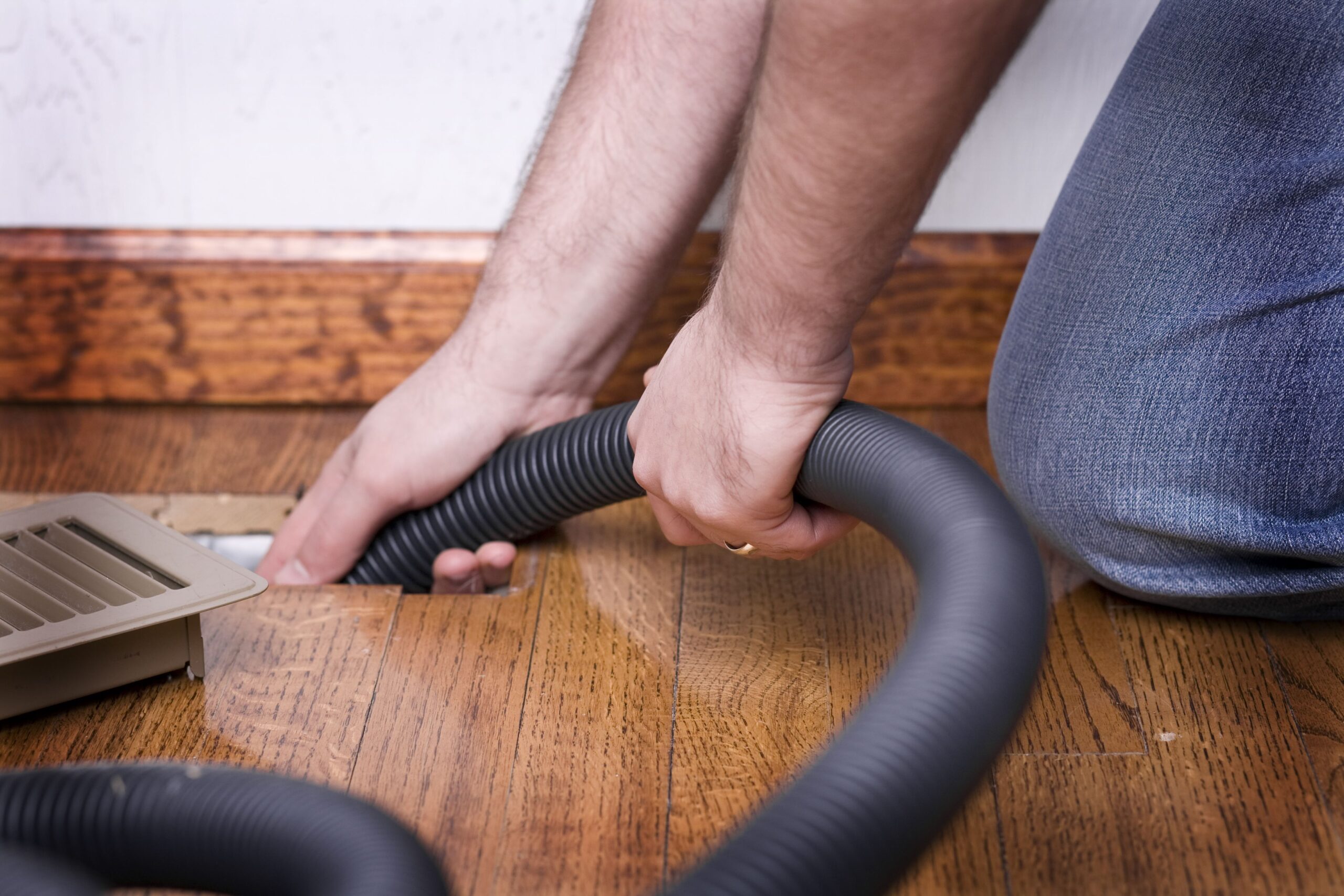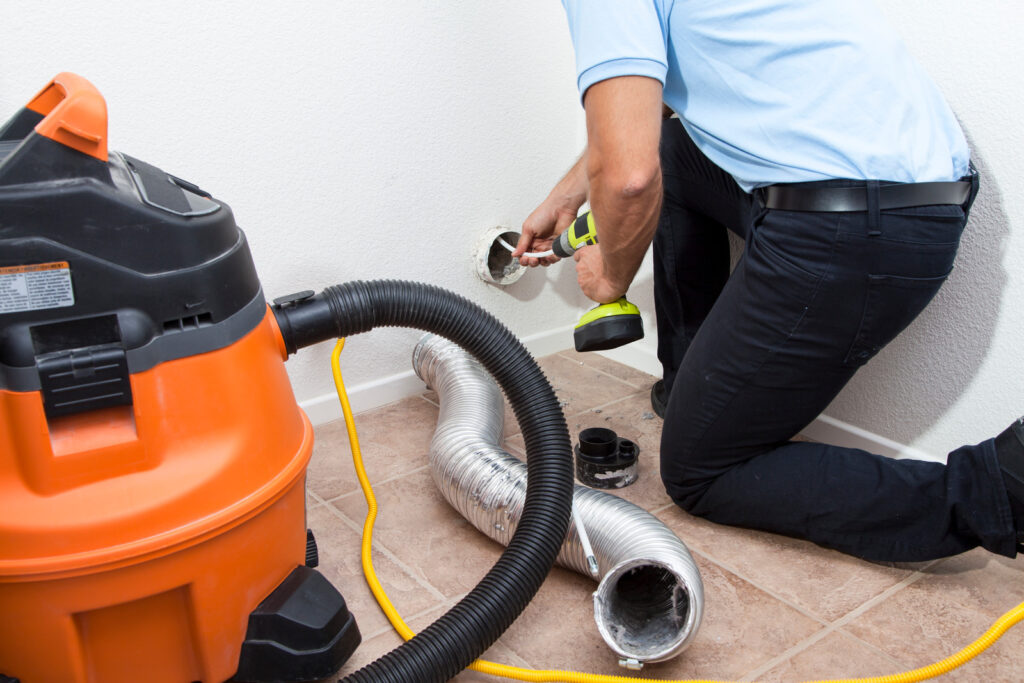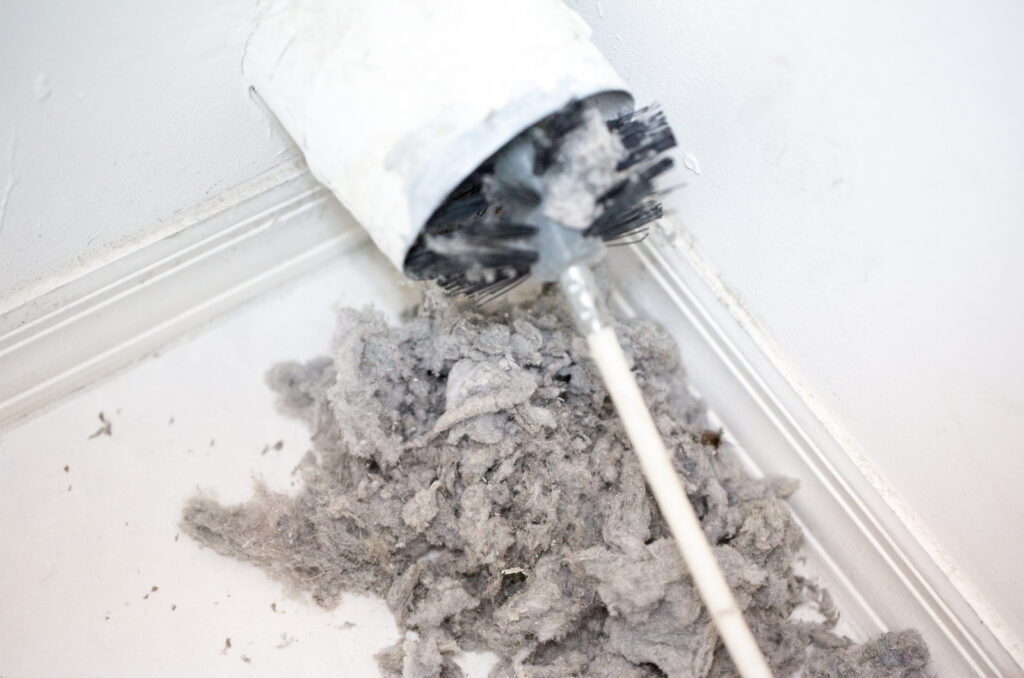
Every household relies on the convenience of a dryer to swiftly and efficiently dry clothes, linens, and other fabrics. Yet, amid the convenience, a hidden danger lurks behind the scenes—the accumulation of lint and debris within the dryer vent. Often overlooked, this seemingly innocuous buildup poses significant property and personal safety risks.
In this comprehensive guide, we delve into the critical importance of regular dryer vent cleaning, uncovering the hazards, preventive measures, and maintenance strategies essential for ensuring the smooth operation of your dryer and safeguarding your home and loved ones.
While dismissing the importance of dryer vent cleaning may be easy, it’s crucial to recognize the potential hazards associated with neglecting this essential maintenance task. Here are some of the key dangers posed by a clogged or obstructed dryer vent:
Regular cleaning is vital to prevent these hazards and maintain safety and efficiency in your home.

Longer Drying Times: If your clothes take longer than usual to dry, it could indicate a buildup of lint and debris in the dryer vent. Reduced airflow caused by obstructions impedes efficient laundry drying, resulting in extended drying cycles.
Overheating Dryer: Touch the outside of the dryer during operation. If it feels excessively hot to the touch, it could indicate that the dryer is overheating due to restricted airflow. Overheating reduces the appliance’s lifespan and poses a fire hazard, as high temperatures can ignite lint trapped in the vent.
Burning Smell: A burning odor from the dryer or laundry room can signal a potential fire hazard. Lint trapped in the vent can ignite under high temperatures, emitting a burning smell. If you detect a burning odor, immediately stop using the dryer, unplug it, and inspect the vent for blockages.
Fluctuating Dryer Vent Hood: Check the exterior vent hood while the dryer runs. If you notice that the vent hood flap doesn’t open fully or remains partially closed, it suggests airflow restrictions due to lint buildup. Proper airflow is essential for expelling lint and moisture from the dryer efficiently.
Visible Debris Around the Exterior Vent: Inspect the area around the exterior vent regularly. Accumulations of lint, debris, or bird nests near the vent indicate blockages hindering airflow. Clearing these obstructions and cleaning the vent can restore proper ventilation and prevent potential hazards.
Regularly monitoring these signs and addressing any issues promptly can help ensure your dryer’s safe and efficient operation while minimizing the risk of fire and other hazards associated with a clogged vent.
A clean dryer vent plays a crucial role in enhancing the efficiency and performance of the appliance in several ways:
Optimal Airflow: A clean dryer vent allows unobstructed airflow from the dryer to the outside. Hot, moist air can efficiently exit the dryer without obstructions such as lint buildup, facilitating faster drying times and reducing energy consumption. Improved airflow also helps prevent dryer overheating, which can lead to component wear and potential breakdowns.
Reduced Drying Times: When airflow is unrestricted, clothes can dry more quickly and evenly. Without a buildup of lint and debris in the vent, the dryer can effectively expel moist air, allowing for shorter drying cycles. This saves time and conserves energy, lowering utility costs and reducing wear and tear on the appliance.
Prevention of Overheating: A clean dryer vent helps maintain optimal operating temperatures within the appliance. When airflow is impeded by lint accumulation, the dryer may struggle to expel heat efficiently, leading to overheating. Over time, overheating can cause damage to heating elements, thermostats, and other internal components, compromising the appliance’s performance and lifespan.
Extended Appliance Lifespan: A clean dryer vent helps prolong the appliance’s lifespan by promoting proper airflow and preventing overheating. Reduced strain on the dryer’s components and improved ventilation contribute to its long-term reliability and durability. Regular maintenance, including vent cleaning, is essential for preserving the efficiency and functionality of the dryer over time.
Energy Savings: Improved efficiency from a clean dryer vent translates to energy savings. Shorter drying times and reduced energy consumption mean lower utility bills for homeowners. Regular vent cleaning helps minimize energy waste and promotes eco-friendly practices within the household by ensuring that the dryer operates at peak efficiency.
Maintaining a clean dryer vent is essential for optimizing the appliance’s efficiency, performance, and safety. By investing in regular maintenance and cleaning; homeowners can enjoy shorter drying times, lower energy costs, and greater peace of mind, knowing that their dryer is operating efficiently and safely.

To mitigate the risk of fires caused by dryer vent buildup, homeowners can take the following proactive steps:
Regular Vent Cleaning: Schedule routine dryer vent cleaning to remove lint, dust, and debris that accumulate over time. Depending on usage and the type of dryer, vents should be cleaned at least once a year, if not more frequently.
Use Metal Ducts: Replace flexible or plastic dryer ducts with rigid or semi-rigid metal ducts. Metal ducts are less susceptible to crushing or collapsing, which can restrict airflow and increase the risk of overheating. Ensure ducts are properly installed and securely connected to the dryer and exterior vent.
Avoid Overloading the Dryer: Avoid overloading the dryer with too many clothes or bulky items. Overloading can prevent proper airflow within the dryer drum, leading to inefficient drying and increased lint production. Follow manufacturer guidelines for load capacity to prevent strain on the appliance and minimize lint accumulation.
Monitor Dryer Operation: Pay attention to any unusual sounds or behaviors from the dryer, such as overheating, unusual odors, or longer drying times. These may indicate a potential issue with the vent system or dryer components that require attention. If you notice any abnormalities, stop using the dryer and investigate the cause promptly.
Professional Inspection and Maintenance: Consider hiring a professional dryer vent cleaning service to thoroughly inspect and clean the vent system. Professionals have the tools and expertise to identify hidden obstructions and ensure that the vent is clean and free of hazards. Schedule regular inspections to address any potential issues before they escalate.
By implementing these fire prevention measures and prioritizing regular maintenance of the dryer vent system, homeowners can significantly reduce the risk of fires caused by lint buildup and ensure the safe operation of their appliances.
Maintaining a clean dryer vent is crucial for ensuring home safety and efficiency. By clearing the way for optimal airflow and ventilation, we reduce the fire risk, improve appliance performance, and save energy. Let’s prioritize dryer vent cleaning in our household maintenance routines to safeguard our homes and loved ones.
Today, schedule a professional vent cleaning or perform a DIY inspection and cleaning. Your home’s safety and efficiency depend on it!